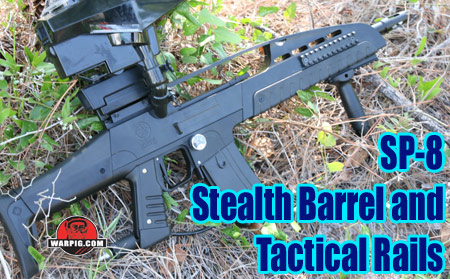  |
|
|
|
|
|
|
  |
|
|
|
|
|
|

What
do you think?
|

SP-8 Stealth Barrel Kit and Tactical Rails By Bill Mills - Photos by Dawn Mills - June 2006 When Smart Parts released the SP-8, along with it came some SP-8 specific accessories, mirroring features found on the real-world XM-8. These included the Adjustable Stock, Stealth Barrel Kit and accessory rails. The standard SP-8 barrel is 14 inches long, and it sits within a foregrip that forms a 7-1/2 inch foregrip. In contrast, the Stealth Barrel kit includes a 20 inch barrel, with a foregrip that extends 12-1/4 inches out past the upper receiver. The SP-8’s standard configuration is analogous to the compact XM-8, while the Stealth Kit mimics the standard XM-8 dimensions.
Both barrels are ported, but due to the length difference the Stealth Barrel’s porting is spread over 6 inches, rather than 2.1. Additionally, the Stealth Barrel’s porting holes are smaller than the stock barrels. They are only 0.085 inches in diameter compared to 0.100. Why the difference? Sound. Quieter operation was one of the design goals for the Stealth Barrel and how it got its name. The Stealth Barrel’s ports are arranged in groups of two and three, which line up air spaces that are formed by the support rips inside its foregrip. The interior support walls of the Stealth Barrel foregrip are of a smaller diameter than those of the short foregrip, and the Stealth Barrel has a smooth polished outer finish, rather than bead-blasted, so that it can fit snugly into the foregrip. The fit is so tight, in an effort to prevent air – and sound – from passing between the chambers, that the Stealth Barrel ships from the factory lubricated with grease to make installation and removal easier.
In use, the extra length on the front of the SP-8 definitely changed its feel and balance from compact to full size. While not as easy to tuck and pivot, the full length foregrip was more comfortable and natural to hold in a typical rifle shooting stance with the adjustable stock extended. The feel changed from the typical hold a paintgun by the grip and vertical regulator (or in the SP-8’s case dummy magazine) to a traditional shooting stance, which helped the use of a red-dot sight feel more natural. The big question for a barrel called Stealth was, “how quiet is it?” To find out, the SP-8 was mounted on the WARPIG Ballistic Labs test stand and fired both with the stock barrel and foregrip, and with the Stealth Barrel and foregrip. Peak sound level measurements were taken at a distance of 10 feet from the muzzle, approximately 45 degrees to the right of the barrel’s central axis.
Over a series of ten shots, the SP-8 averaged 54.8 dB peak sound output. Over ten shots under the same conditions, the SP-8 fitted with the Stealth Barrel Kit averaged 52.7 dB peak sound output. While not huge, the Stealth Barrel Kit did produce a measurable sound reduction of just over 2 dB. Not apparent from the sound level data was how the Stealth Barrel changed the quality of the sound. With the Stealth Barrel Kit in place, the tone of the SP-8s report was altered. While this observation was purely subjective, it seemed more difficult to locate by hearing alone.
The two side rails are 4.585 inches in length, and mount via included screws on either side of the foregrip. The screws bite into screw holes that are pre-molded into the foregrip. These side rails are positioned to accept accessories like flashlights, lasers, or even red-dot sights for players who prefer to sight along the side of the barrel.
For testing, we fitted an RIS vertical grip on the lower rail. With the Stealth shroud it proved effective while shooting from the hip, but in a shouldered position the rubber grip built into the Stealth foregrip was still preferred. With the standard barrel and shroud, and the butt-cap instead of a stock, however a vertical grip on the bottom accessory rail gave the SP-8 the compact feel of a PDW (personal defense system) configured weapons system.
The Accessory Rail Kit and Stealth Barrel
Kit from Smart Parts integrated into the SP-8 without problem, and gave
it more versatility in terms of configuration, while maintaining its Milsim
form, mimicking the XM-8 Battle Rifle.
|
| Copyright © 1992-2019
Corinthian Media Services. WARPIG's webmasters can be reached through our feedback form. All articles and images are copyrighted and may not be redistributed without the written permission of their original creators and Corinthian Media Services. The WARPIG paintball page is a collection of information and pointers to sources from around the internet and other locations. As such, Corinthian Media Services makes no claims to the trustworthiness or reliability of said information. The information contained in, and referenced by WARPIG, should not be used as a substitute for safety information from trained professionals in the paintball industry. |